When I surveyed the Summer Road Trip schedule to start the season, my most highly anticipated week was my rendezvous with the V8 Supercars.
It wasn’t because I’d been successful in those cars before. In fact, the opposite was true. I’d barely driven them at all, but I sensed great potential.
After all, no other road car drives as much like a big, heavy stock car than the high-horsepower, low-grip beasts from Down Under. And like a stock car, these cars don’t tolerate being overdriven, which I expected would play to the strengths of my conservative driving style.
My only foray into the current V8s came last summer, when the NEO Endurance Series hosted a one-off race around Imola. I partnered with Dean Moll to run in the event, and while we finished and had fun in the process, my driving was a bit rough around the edges.
I could run decent laps when I was by myself, but as soon as I caught another car, I would start making mistakes. It was as if every car emitted a force field that rendered me completely unable to drive as I approached.
As I took to the V8s again this week around Imola — a fortuitous alignment of the official series schedule with my road trip plans — I hoped to build on my experience with this car and track, not only finding speed but limiting mistakes in pressure situations.
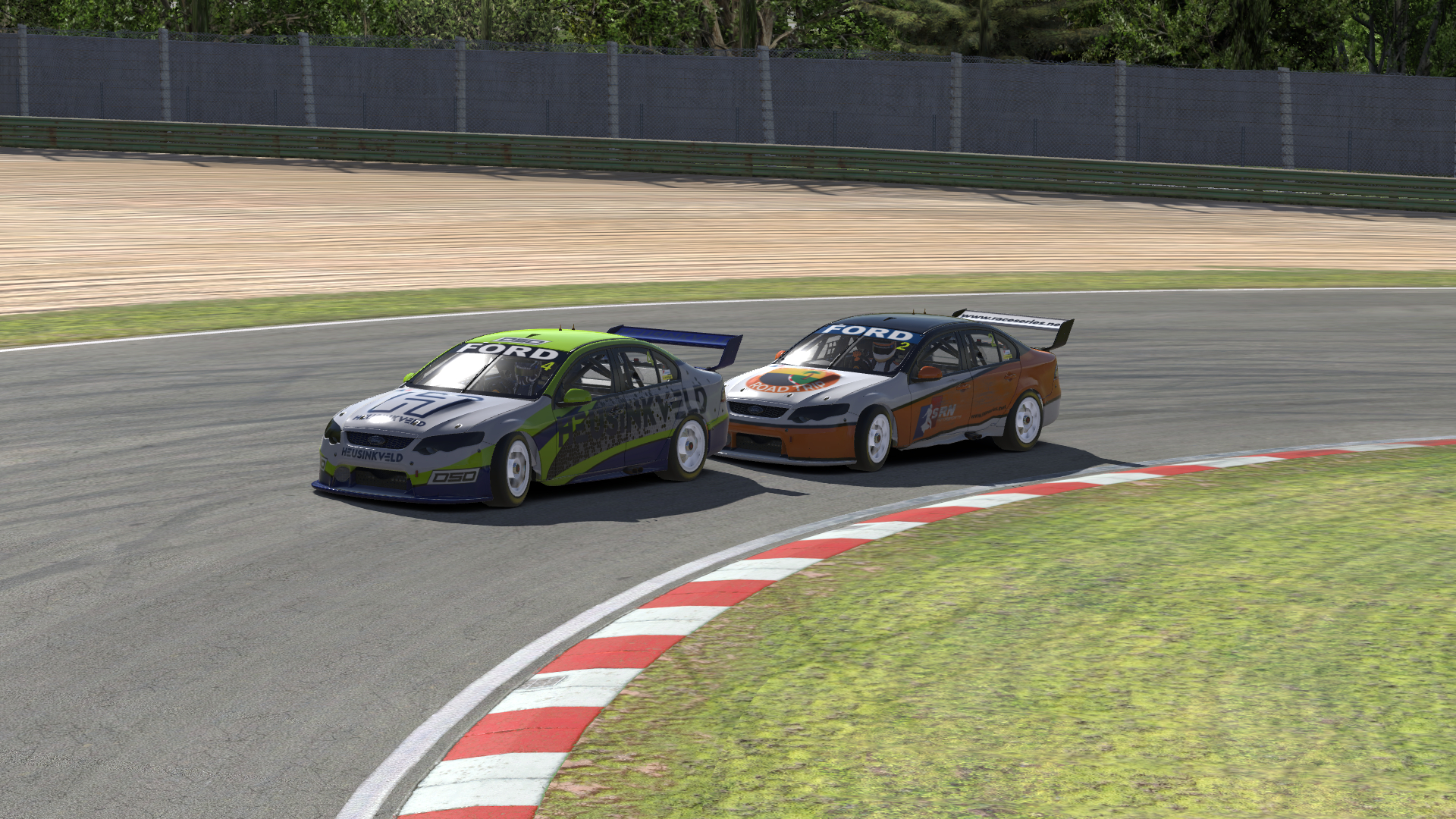
Bumper-to-bumper racing in the Tosa corner.
The Shakedown
Like a Tasmanian devil, the V8 is a wild animal. Experience with the Porsche, which also lacks anti-lock brakes and traction control, would certainly help an aspiring V8 driver, but it’s still a shock to the system to get used to the extra 150 horsepower, 230 additional pounds of weight, and narrower tires of a V8 Supercar.
If the Porsche is a bit temperamental, the V8 is a full-on temper tantrum: tough to control and prone to misbehavior at the most inopportune times. Wheelspin isn’t a threat; it’s a promise. And slowing the car down can be just as much of a challenge as getting back on the throttle.
A solid setup like the one from Virtual Racing School that I used and modified can make the car more stable and, in my case, a few tenths quicker than the baseline, but it won’t suddenly make the car driveable. It’s up to the driver to tame this car.
A quirk of the British empire adds one extra challenge: The V8 is a right-hand drive car, so it’s easy to get the left side a little too close for comfort to walls, grass, or raised kerbs if you’re not careful.
This car also requires more in-race strategy management than in most lower-level series. Race distances are variable, from 30-minute sprints to nearly hour-long enduros. Some weeks also use fuel limits to force a pit stop, as was the case with last week’s races at Imola.
Undoubtedly due in part to the difficulty of driving these cars, participation in the V8 series is fairly limited, with only a handful of official races per week, primarily in Aussie-friendly timeslots.
To give Americans a chance to race this car, the V8 community organizes two races per week during US evenings: one on Thursday night, known as the sportsman race, and one on Friday night that also tends to attract some strong competition from the top southern hemisphere-based drivers.
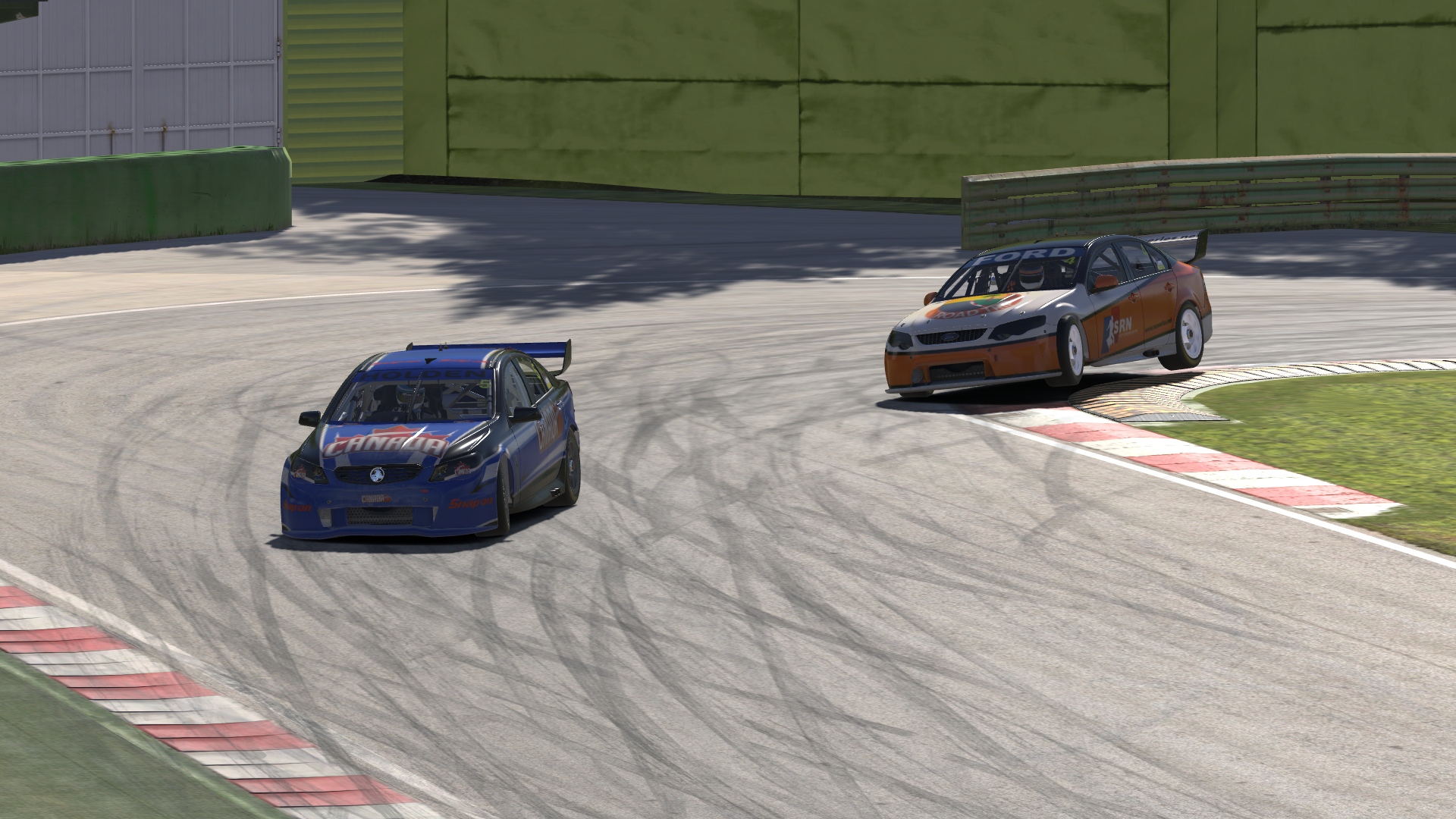
Hopping the kerbs behind another North American driver in the Variante Alta chicane.
To the Outback
Leading up to the first race of the week, I ran dozens of practice laps and felt comfortable and confident when driving by myself. I even practiced pit stops, making sure I knew my braking point getting onto pit road and how much fuel I needed to add.
My solo driving experience paid off, as I qualified second in the field of 12 cars. But one thing I hadn’t practiced soon stared me right in the face: standing starts.
In the NEO race, Dean handled the start, and it’s not something I thought to practice. After all, I’d just done them in the Porsche with no problem, so how hard could it be? Nail the gas and dump the clutch when the lights turn green, right?
If you expected anything to be easy in the V8s by now, then you’re sorely mistaken, as I was once the race began. When I hit the gas, the car did an impressive burnout, then spun the tires most the way to turn 1. By then, half the field had already passed me and I was forced to go side-by-side through the first chicane.
Then things got even worse.
The Australian driver next to me had a high latency to the race server, which interpreted our close racing as contact. That sent my car onto its side and spinning into the grass. After the entire field had passed, I finally got going again.
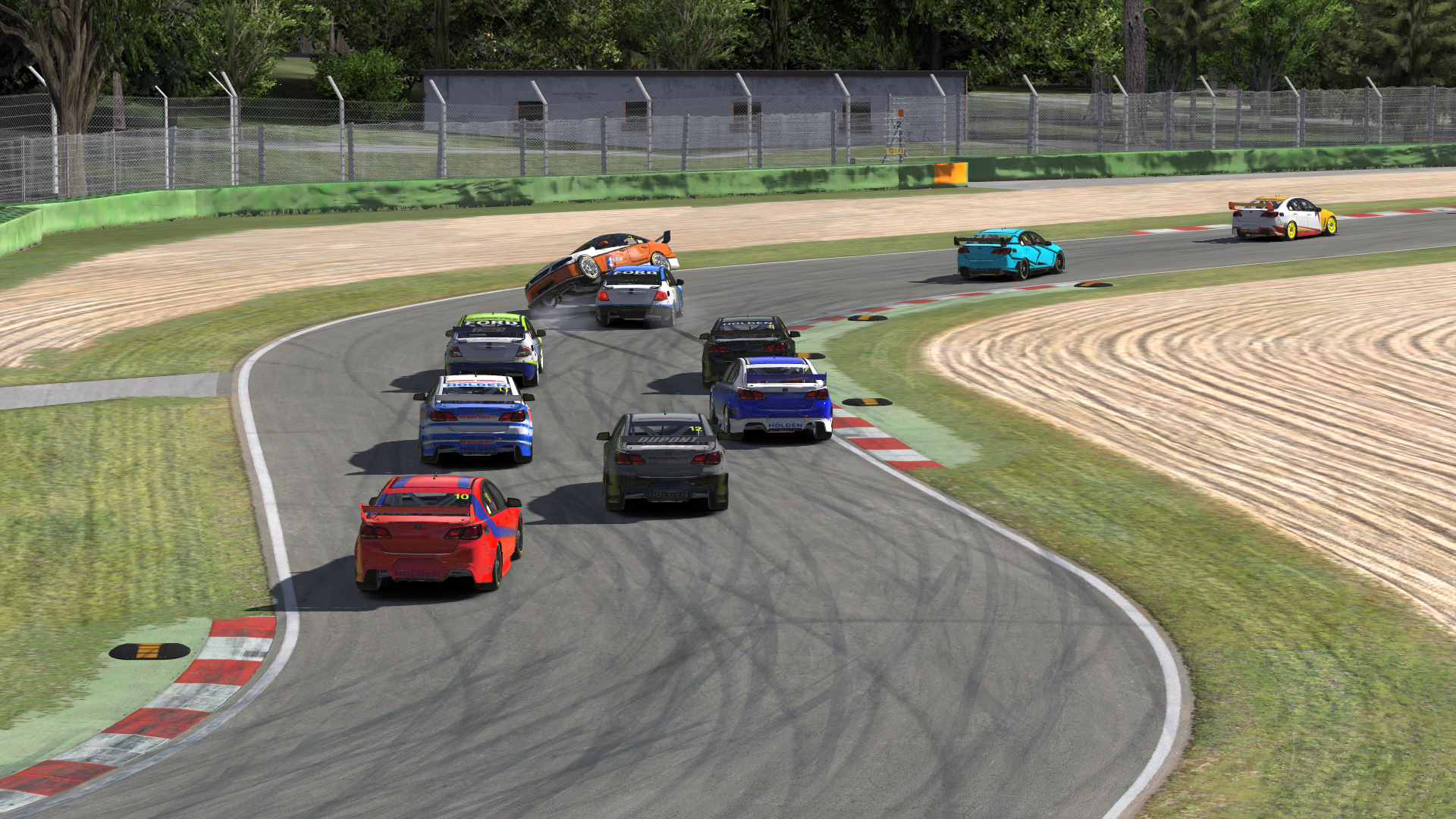
Crashing in the first turn after phantom contact with another car.
Men at Work
One thing working in my favor was my pace. I was one or two seconds per lap faster than most of the cars ahead of me, so I figured that I’d get past them easily.
Once I started to catch them, I was surprised by the aggression of almost everyone in the field. Slower drivers who pulled over to let me pass in practice were holding nothing back in the race.
I can’t blame them for that. In a car as tough to drive as the V8, keeping another car behind you might force a mistake from them. That happened to me early on, when I clipped a kerb too closely with the left-side tires and had to slow down to serve a penalty, which temporarily cost me a position.
Eventually, I passed most of the field and made my pit stop, which put me in third position. I was catching the second-place car and — frustratingly — the leader, but his advantage would be too much to claw back, so I set my sights on second.
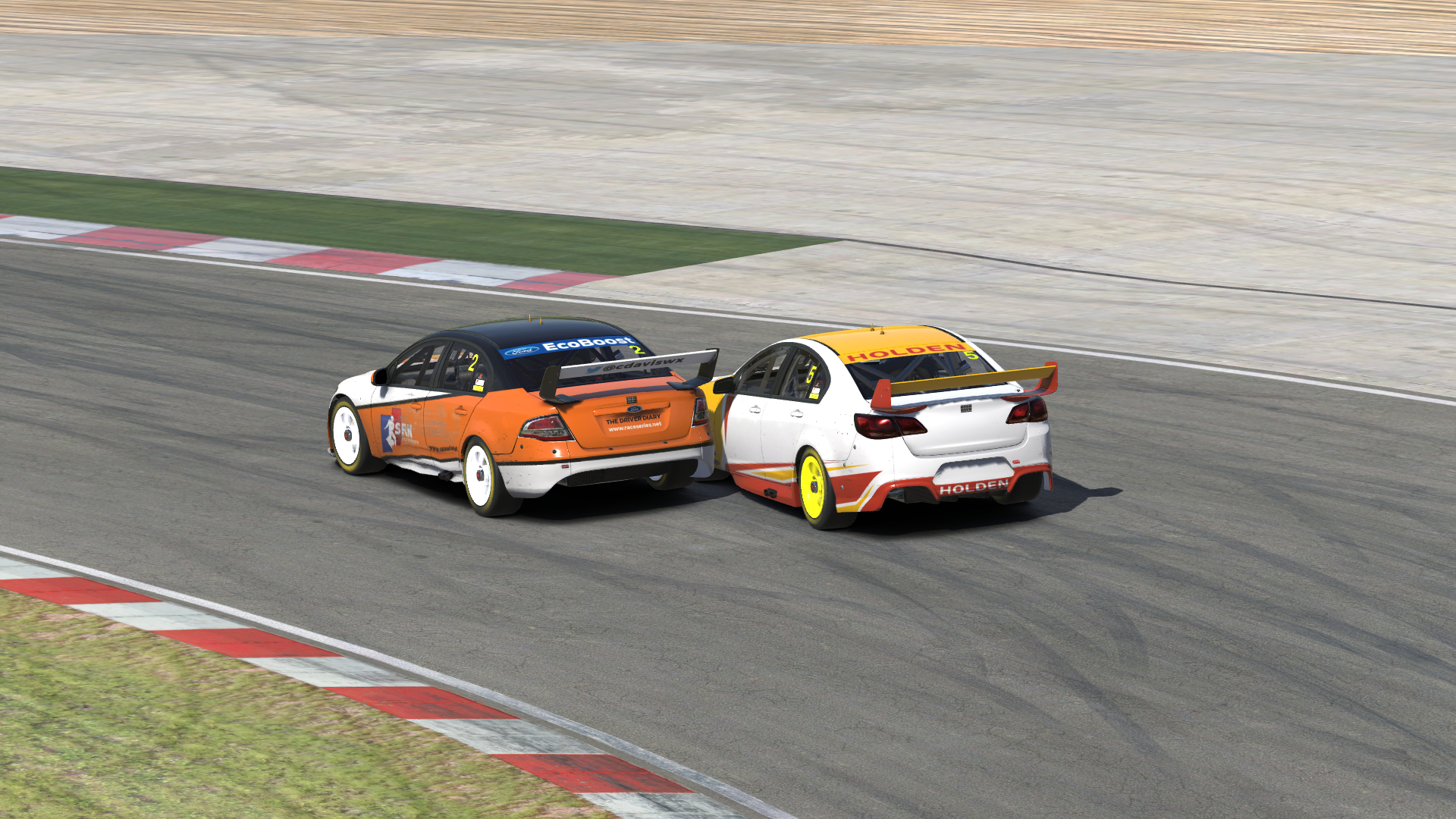
Making a move for second place through Piratella.
With two laps to go, I finally got a run on him into the Piratella complex, a quick double-apex left-hander. I pulled to his inside and had my nose ahead, but on exit, I drifted a bit wide and nearly hit his car, which forced him to check up and concede the position.
He was none too pleased with my move, saying that I should’ve been able to pass him cleanly without driving into his lane. In my defense, after almost everyone else in the field raced me so hard, I figured my move wasn’t so out-of-line, especially with two laps to go.
Regardless, I had the position and just had to complete the final lap and a half without making a mistake, which isn’t always easy on old tires. I came home in second place but couldn’t help but think what might have been if not for my mistake at the start.
V8 Supercars Series - Race 1
Thursday, July 6 at 8:15 pm EDT • Strength of Field: 2275| Finish | Start | Interval | Laps Led | Fastest Lap | Incidents | Points | iRating | Safety Rating |
|---|---|---|---|---|---|---|---|---|
| 2 | 2 | -8.933 sec. | 0 | 1:44.412 | 13 | 120 | 4595 (+25) | A 3.48 (-0.67) |
A Great Barrier
All day on Friday, I was excited about having another chance in that night’s race. I expected some of the series’ heavy hitters from Oz would be there, but I welcomed the opportunity to test myself against them.
For that race, I qualified in fourth and made sure to do plenty of practice standing starts, each time easing onto the throttle more gradually until I had no wheelspin.
It paid off, as I got off the line well and held my position through the opening corners. However, on cold tires — yes, that’s another venomous creature waiting in this car’s bushes if you overstep the bounds — I ran wide midway through the lap, which cost me one position and put me side-by-side with another car entering the tight Variante Alta chicane.
If I lifted early, I knew that I’d lose at least one more spot, if not two to the cars lined up behind me. So I instead played a game of chicken into the braking zone, and when the car to my inside didn’t blink, I bailed out. Unable and unwilling to try to fit two cars through the chicane, I took to the grass to cut the corner.
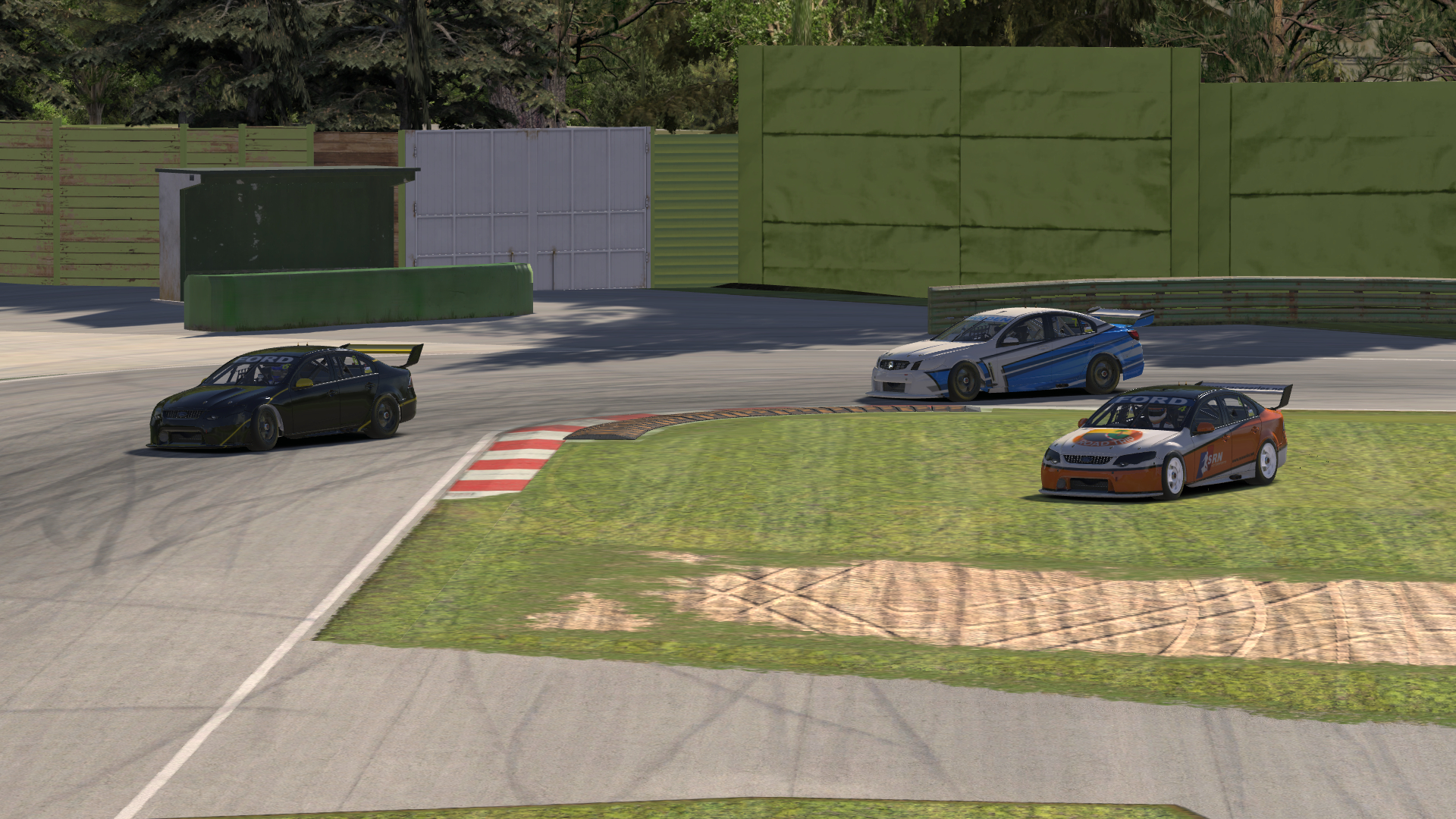
Driving off-road to avoid a two-wide squeeze through the chicane.
Of course, that warranted a slowdown penalty, and in iRacing, those are particularly harsh on the first lap of a race since you haven’t yet set a reference time for traversing each corner.
I eased off the throttle on the frontstretch, with cars blowing past me all the while. But even that wasn’t enough. I didn’t serve the penalty in time and was handed a 16-second stop-and-hold penalty.
After making that agonizingly long stop, for the second straight race, I was stuck in the back. This time, though, there was no drama of a comeback onto the podium. The setback from my penalty was too great and there were too many fast cars too far ahead to make much headway.
I was left to lap mostly by myself and try to avoid incidents to stop the bleeding from my safety rating. But like pretty much everything in this car, that was tougher than it sounds.
I gained a few spots from attrition, passed a couple of backmarkers, and on the last lap, got by a driver who was in heavy fuel-saving mode to finish in 14th place.
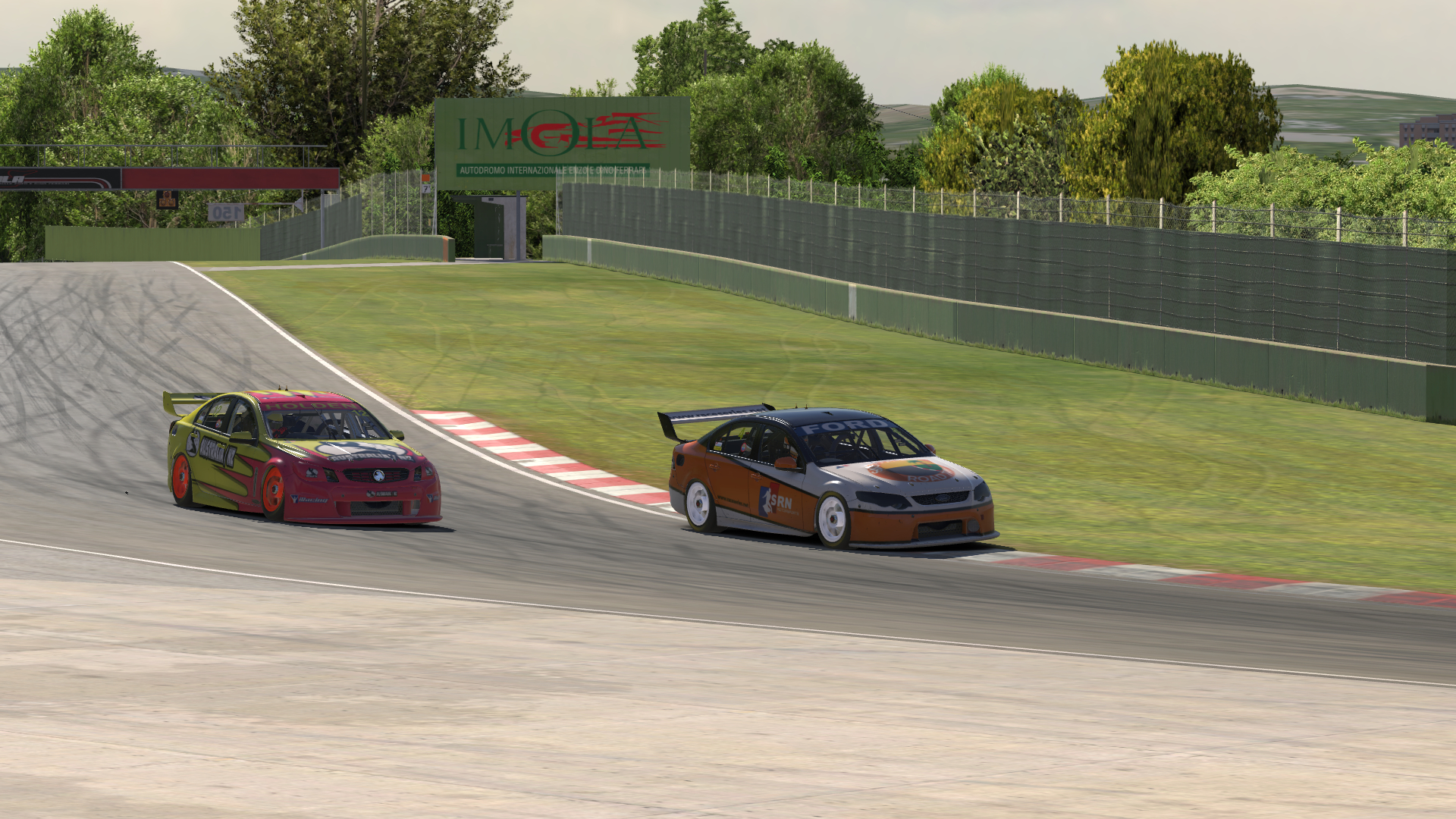
Making a last-lap pass to pick up one more position.
V8 Supercars Series - Race 2
Friday, July 7 at 10:15 pm EDT • Strength of Field: 2281| Finish | Start | Interval | Laps Led | Fastest Lap | Incidents | Points | iRating | Safety Rating |
|---|---|---|---|---|---|---|---|---|
| 14 | 4 | -1:22.414 sec. | 0 | 1:45.402 | 8 | 57 | 4533 (-62) | A 3.39 (-0.09) |
Blimey, Blame Me
I can’t remember the last time I lost more than a position or two on a start. Or the last time I got called out for unclean driving. Or the last time I had to serve a black flag penalty in the pits.
Well, I couldn’t remember until last week, at least.
A car from the opposite side of the world with the seat on the wrong side made me drive backwards myself. Instead of my usual patient, calculated style, I was aggressive and making mistakes. The red mist bred missed chances in two straight races.
I’m sure it’d be easy to read this and become discouraged about racing the V8 Supercars, but I hope that isn’t the takeaway; my issues were all due to my own mistakes and not because of the car, the competitors, or the series.
To be sure, I actually really like driving these cars. I’ve said a lot about how tough they are, but I live for that sort of challenge; why else would I have driven the asphalt sprint car for two seasons?!
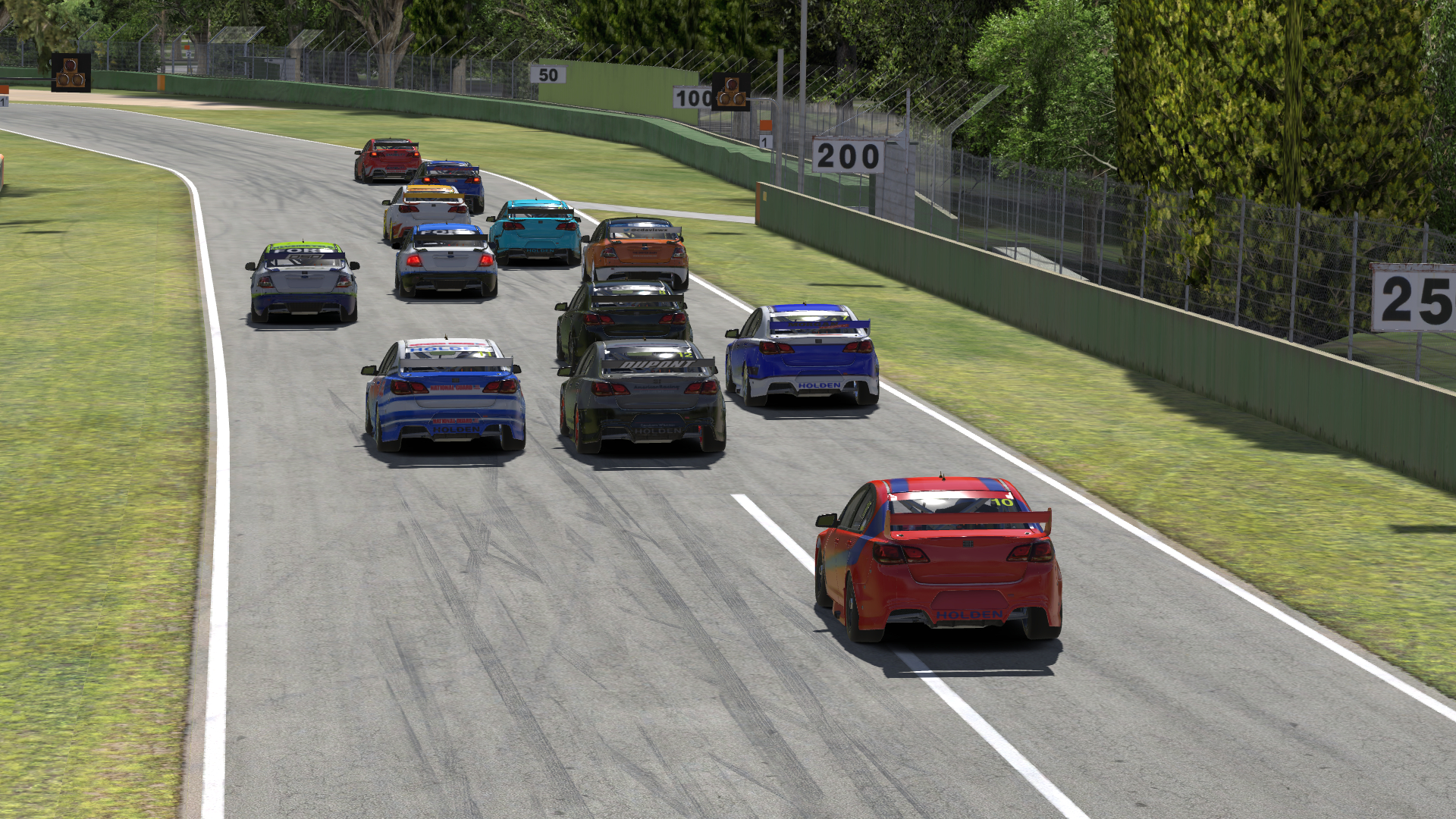
Slipping back through the field after my botched start in race 1.
Maybe iRacing’s V8 Supercars are more difficult to drive than their real-life counterparts — in the past, professional V8 drivers trained on iRacing in the GT3 BMW rather than the V8 because it drove more like the real thing — but tire and chassis physics improvements in the past few years have actually made this car a more tameable beast than it once was.
I also like that the drivers in the official series race one another hard but fairly. It makes every position gained and battle won that much more of an accomplishment.
My only frustration about the official series is the toll it can take on safety rating after the almost inevitable off-tracks that you tend to take in this car. Because of that, perhaps it’s no wonder that leagues like V8SCOPS and OSR are flourishing and often more popular than the official series.
But even the official series provides a league-like atmosphere since you can race the same group of drivers every week, learning their pace and tendencies over time. In my years of oval league racing, that was always one of my favorite parts.
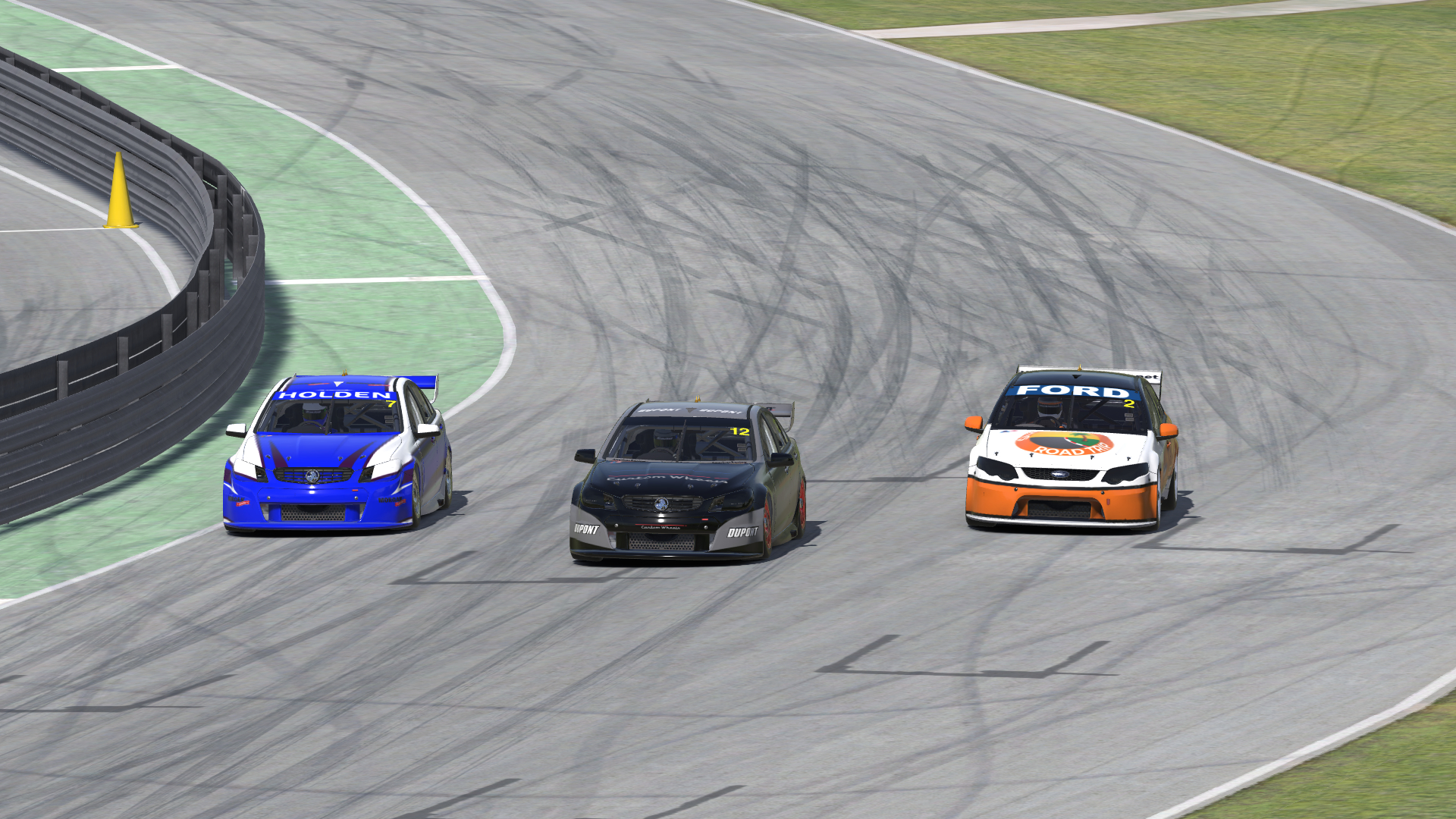
Racing three-wide down the frontstretch.
So would I recommend this series?
If you love a good challenge, then absolutely. Just know that success — or failure — in the V8s might not translate to other cars.
Like the koala or the kookaburra on the tree of life, it’s easy to dismiss the V8 Supercars series as an odd offshoot that doesn’t matter in the grand scheme of high-level GT racing.
Regardless, I want so desperately to be good at it. It might not be this season or even this year, but someday, I plan to return to this car and realize my full potential.
I want to race in, finish, and even win the Bathurst 1000. I want to storm off the starting line and race side-by-side against other cars, cold tires be damned. I want my experience to be one of fun rather than frustration.
And if that’s too much to ask, I just want to make it through the first lap without screwing up.